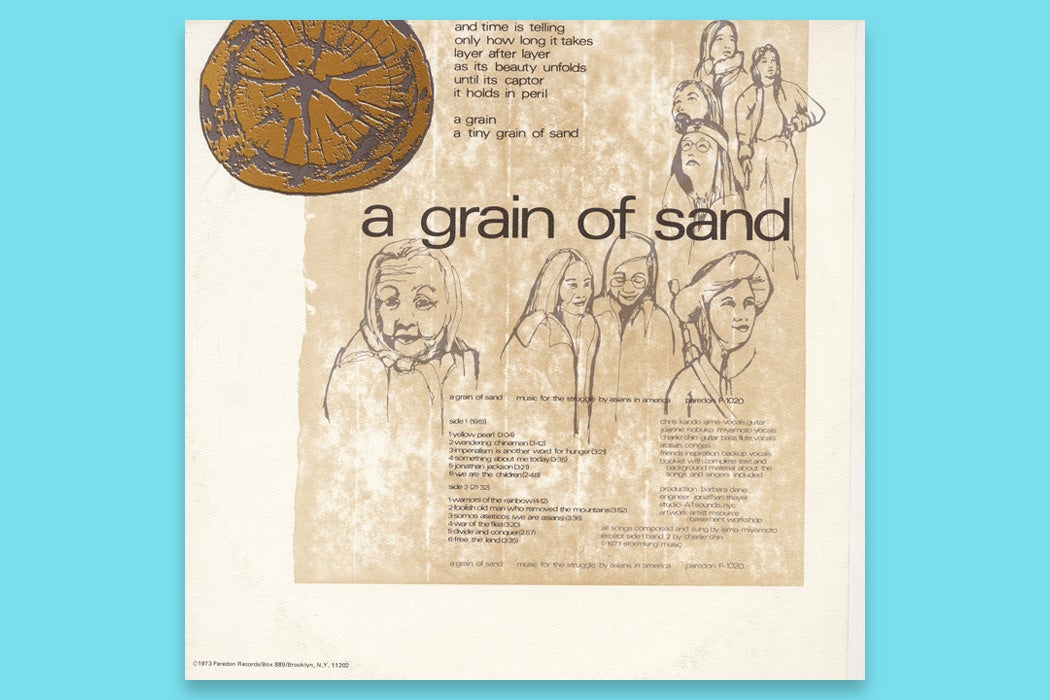Is it possible to forge a new identity through music? That was what the 1970s American folk trio A Grain of Sand set out to find out. Founded in 1971, A Grain of Sand comprised guitarists Chris Kando Iijima and William “Charlie” Chin with singer Nobuko Joanne Miyamoto; they performed in settings like rallies and college campuses. But as they toured the US, they also worked to be a bit different from other folk groups.
“For one thing, they didn’t simply make music for the movement—they came out of the movement,” writes sociologist Oliver Wang.
The movement in question is the Asian American Movement, which ran from the 1960s to the 1980s. Its “greatest legacy,” as Wang notes, was to unify diverse groups such as Chinese Americans, Japanese Americans, and Filipino Americans into a viable political and social entity. In fact, A Grain of Sand came together originally in response to the murder of a Japanese American woman at the 1970 convention for the Japanese American Citizens League, the oldest Asian American civil right organization in the US. Their music—their 1970 West Coast tour—helped raise money for a memorial fund.
Music by groups like A Grain of Sand was an integral part of what Wang describes as “fundamentally a cultural movement…with expressive culture serving as a prime force in constructing the new Asian American nation.”
Wang describes their oeuvre as an effort to take Asian American political thought away from the academy and “out to a popular audience to take root and proliferate,” noting that
[o]n their self-titled album, released in 1972, it seems as if the band distilled down all the major tenets of the movement into a record: odes penned to panethnic identity, cross-racial coalition building, a class analysis of racial oppression, a treatise against American imperialism in South East Asia, and calls for Asian Americans to take pride in their heritage.
Wang is cautious not to overplay the representative nature of the band. Numerous other Asian American musicians were active in the 1970s, but their output was not as overtly ideological.
“However, it could also be argued that the mere presence of Asian American bands—many of them deliberately panethnic in their composition…was a political statement in and of itself,” he adds.
These bands adopted an image in the music industry that wouldn’t have been possible in the decades prior, during what Wang dubs “the ‘pre-panethnic’ era” from the 1950s to the late 1960s. Immediately after World War II, Asian American performers—who were often second- or third-generation citizens—had to play up their American bona fides in ways that stressed assimilation.
Movie star James Shigeta, for example, put out an album in the late 1950s that served up “almost all completely Tin Pan Alley standards,” writes Wang, with “no use of pentatonic scales…or the ubiquitous gong that starts other songs marked ‘Oriental.’” Meanwhile, liner notes and reviews “handled carefully” the question of Shigeta’s race, by emphasizing that he was a “Honolulu-born, college educated” veteran of the Marine Corps.
Weekly Newsletter
Many years after A Grain of Sand, Asian Americans are now “attached to the Asian American Movement mostly through collegiate education, not direction participation,” Wang observes in his article, which was published in 2001. Contemporary musicians range from rappers painting portraits of their everyday lives to artists who try to place their work in “a more global perspective” that bridges Asian and US culture.
Pondering the potential for “an influx of Asian artists” into the American music industry, Wang asks, “[W]ould that be a sign of America’s embrace of Asian Americans? Or simply another example of America’s hunger to consume ethnic chic fashion?”
In an age where South Korean k-pop boy band and global sensation BTS can be invited to the White House to speak about anti-Asian hate crimes, Wang’s question feels more timely than ever.







